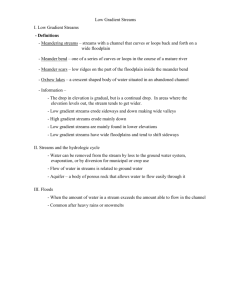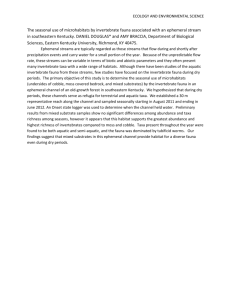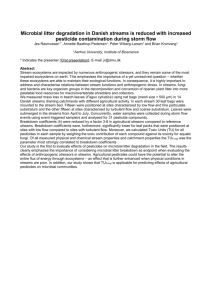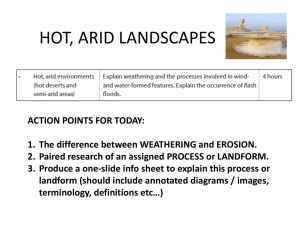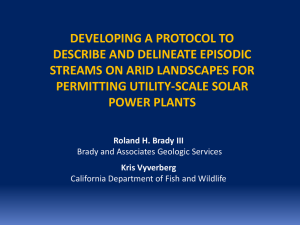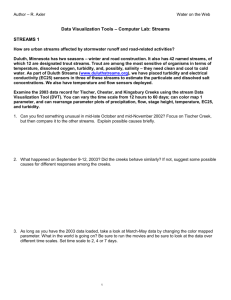Zuni Pueblo Case Study
advertisement
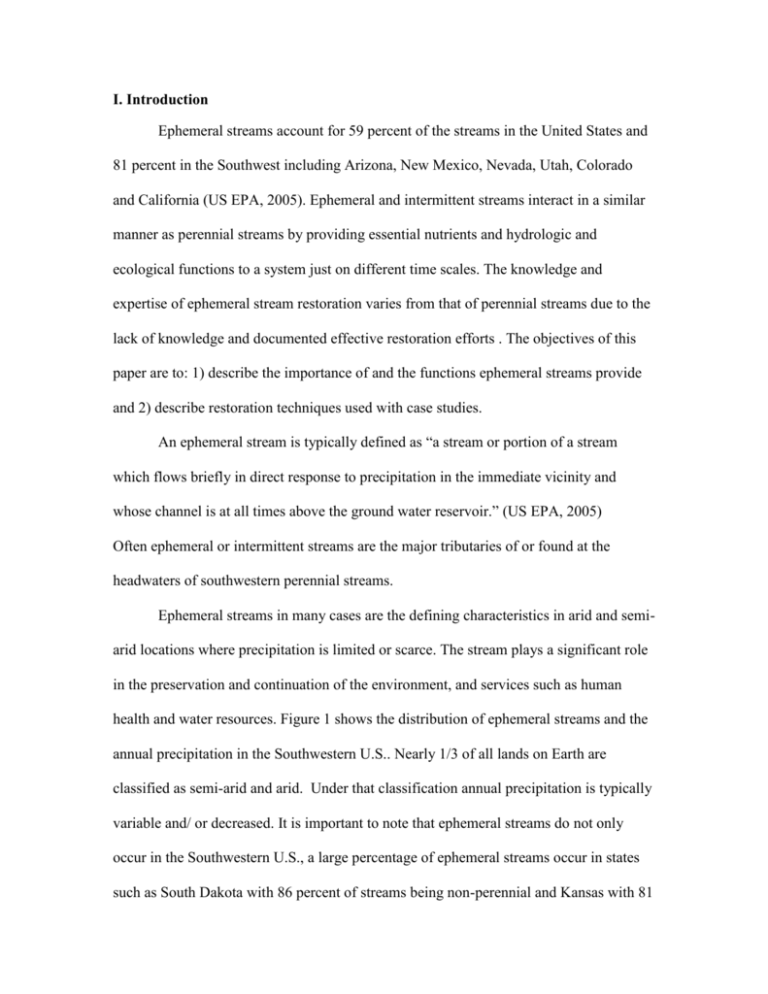
I. Introduction Ephemeral streams account for 59 percent of the streams in the United States and 81 percent in the Southwest including Arizona, New Mexico, Nevada, Utah, Colorado and California (US EPA, 2005). Ephemeral and intermittent streams interact in a similar manner as perennial streams by providing essential nutrients and hydrologic and ecological functions to a system just on different time scales. The knowledge and expertise of ephemeral stream restoration varies from that of perennial streams due to the lack of knowledge and documented effective restoration efforts . The objectives of this paper are to: 1) describe the importance of and the functions ephemeral streams provide and 2) describe restoration techniques used with case studies. An ephemeral stream is typically defined as “a stream or portion of a stream which flows briefly in direct response to precipitation in the immediate vicinity and whose channel is at all times above the ground water reservoir.” (US EPA, 2005) Often ephemeral or intermittent streams are the major tributaries of or found at the headwaters of southwestern perennial streams. Ephemeral streams in many cases are the defining characteristics in arid and semiarid locations where precipitation is limited or scarce. The stream plays a significant role in the preservation and continuation of the environment, and services such as human health and water resources. Figure 1 shows the distribution of ephemeral streams and the annual precipitation in the Southwestern U.S.. Nearly 1/3 of all lands on Earth are classified as semi-arid and arid. Under that classification annual precipitation is typically variable and/ or decreased. It is important to note that ephemeral streams do not only occur in the Southwestern U.S., a large percentage of ephemeral streams occur in states such as South Dakota with 86 percent of streams being non-perennial and Kansas with 81 percent non-perennial streams. Ephemeral streams are important because they provide the same critical functions as perennial streams such and transport sediment, move water, nutrients, chemicals and other debris as well as “provide connectivity within the watershed.” (US EPA, 2005) Figure 1: Annual precipitation and location of ephemeral streams in the Southwestern United States from the EPA (2005). Currently Federal law protects “waters of the United States” under the 1948 Clean Water Act (CWA). The CWA was originally established to “restore and maintain the chemical, physical, and biological integrity of the Nation’s waters.” For years ephemeral streams had been considered to fall under “waters of the United States” until recently when Supreme Court cases in 2006 argued that in the case of non-navigable, intrastate and isolated waters a “significant nexus” needed to be present in navigable waters to be considered under the CWA. What is unclear is the definition of a “significant nexus” which has yet to be defined and if ephemeral streams should be included in the CWA. Under 33CFR, Part 328.3 intermittent streams are mentioned and included as well as tributaries of waters. As with most laws there is some room for interpretation, if ephemeral streams are to fall under the CWA and be considered “waters of the United States” then the integrity of the streams a would be protected in the interest of the people. Ephemeral streams should be included under the CWA if they are tributaries and the remaining streams that make up a majority of the streams in the U.S. southwest would be in question (US EPA, 2005). Many of the current issues for ephemeral stream restoration surround the fact that there is little known about restoration efforts and whether those efforts have been successful or not. There have been countless restoration efforts and studies on perennial streams and their responses to different land use changes. There is little known about the responses of ephemeral streams in dryland systems due to the extreme variability of responses and precipitation both temporally and spatially (Chin and Gregory, 2001). II. Physical Characteristics Ephemeral streams can be apart of perennial streams by segmenting the flow due to changes in river geology. When the flow is interrupted it is often referred to as “intermittent” or “spatial intermittent” to illustrate the locations along a river where it is segmented. Within an active stream channel there are multiple zones that interact with one another and play an important role in nutrient, trace elements and biogeochemical cycling and exchange. The zone that is located between the alluvial ground water and the stream channel is known as the hyporheic zone. The hyporheic zone helps to provide the stream with chemical, biological and physical integrity. In ephemeral streams the hyporheic zone can be present and provide the system with needed nutrients. When water flows the alluvium and surface water interact exchanging nutrients required for life in an aquatic environment. The zone located within the active channel that lacks surface water is known as the parafluvial zone. The two zones along with the riparian zone and the stream collectively make up the desert stream ecosystem (US EPA, 2005). Hydrology As a rule of thumb ephemeral streams tend to be closely located which causes the drainage density to be high and most likely braided. The result is high erosion rates and a high width-to-depth ratio with increased sediment concentrations. They also tend to have low sinuosity in comparison to humid regions. Since flows in ephemeral streams are rapid and infrequent and tend to be extreme it is very difficult to reach and determine bankfull flows. Identifying the bankfull flow since the channel changes so frequently that it requires special attention to point bars and other features of disposition at consistent elevations (Arid SW Regional Report, 2003). A report by Moody et al, 2003 reported the greatest inconsistency in results of bankfull identification in ephemeral streams and sand beds due to the fact that the needed identification features were not consistent apparent. Variability In general ephemeral streams are characterized as lacking permanent flow with extreme and rapid flood variations. In most arid and semi-arid locations vegetation is sparse and the soil lacks organic matter allowing stream flows to generate greater amounts of erosion and runoff, increasing and varying the magnitude of a flow. As stated earlier, precipitation varies both temporally and spatially thus it is very difficult to predict the degree to which a flood will transport sediment and the resulting hydrologic impacts. For example on the Gila River in Arizona the 50 year return flow is about 280 times that of the mean annual flow compared to the return flow on a river in Pennsylvania that receives 2.5 times that of its mean annual flow (US EPA, 2005). Stream flow variability can also be in the context that it is difficult to classify a once perennial stream that goes dry as an ephemeral stream as stated by Stanley et al, 2007 Desert streams are “spatially dynamic ecosystems that undergo cycles of expansion, contraction, and fragmentation, that conventionally hydrologic measurements of water velocity or volume passing a fixed point represent in only one aspect of hydrologic dynamism.” During flooding events the channel is constantly changing rarely resulting in equilibrium or a static state. The typically ephemeral hydrograph is different from that of a perennial stream in that the initial runoff is rapid and results in a rapid and steep rising limb and falling limb over a short time frame. The initial peak discharge is reached rapidly and the recession is considerably longer and takes a longer time to dissipate. Often the entire hydrograph is the recession curve (EPA, 2005). Unlike perennial streams, unique to ephemeral streams is the significant loss of transmissivity downstream when they flow. Due to the variability of groundwater recharge and other factors the transmission rate tends to increase where as perennial streams do not tend to see transmission losses. Under certain conditions, flows can be completely infiltrated before reaching the watershed outlet. However transmission rates greatly depend on the location the precipitation occurs, the channel conditions and the discharge and duration produced by a particular storm event. Near Tombstone, Arizona, the Walnut Gulch Experimental Watershed has observed peak flows of 107 m3/s with a volume of 246,000 m3 at Flume 6. Traveling a distance of 10.86 km across a dry streambed to the next monitoring site, Flume 1, the peak discharge decreased to 53 m3/s resulting in 90,800 m3 of water to be lost to the alluvium (EPA, 2005). As seen in Figure 2 from Goodrich et al (1997) the transmission losses increase as the flow travels downstream. Figure 2: Walnut Gulch Experimental Watershed near Tombstone, AZ hydrograph depicting the transmission losses from an August 27, 1982 storm event. According to the EPA (2005) multiple authors have suggested that the results from transmission losses downstream tend to cutoff or seal off tributary channels due to the deposition from “seepage-induced discharge.” This increases the gradient in the valley and forms gullies and a “reintegration of the system by arroyo cutting in the fills.” The end result is multiple scour and fill episodes that alter the channel and result in aggradation. The appropriate combination and intensity of flood events to reverse aggradation is still to be determined. Sedimentation Ephemeral streams and the extreme events that occur in them play a particularly important role in movement of sediment and other nutrients. Even though extreme flooding events do not occur frequently in ephemeral streams they make up 5 percent of all flooding events. Of those events they can transport up to 65 percent of the sediment load in a particular stream. During a flooding event the channel becomes connected rather than disconnected however compared to perennial streams or humid areas where recovery is rapid, recovery occurs on much longer time scales in arid locations (Chin and Gregory, 2001). The more frequent small flood events that deposit small amounts of sediment tend to aggregate and can play a considerable role in channel aggradation. This is also seen in the downstream sections of channels where the transmission increases and the amount of silt and fine sediment deposited increases. The end result is a potential habitat for biotic species that create a viable microhabitat for multiple organisms. As a result the “alluviation patterns associated with the hydrologic regime strongly influence the structure, productivity, and spatial distribution of biotic communities in ephemeral river ecosystems” (EPA, 2005). On the other hand the upper sections of channels and the amount of sediment brought from the upper reach can have a detrimental effect on the downstream channel when sediment rates are increased. The channel can change and result in instability and destroy or inhibit the overall productivity of the stream by cutting off the habitat structure for invertebrates, fish and microorganisms (EPA, 2005). III. Management Difficulties with Restoration The extreme variability of ephemeral streams and the inability to predict the result of a flood event makes restoration difficult. Also due to the fact that flows are not consistent and difficult to predict when a flood event will occur, the desire and need to restore the streams is not as prevalent as a stream that flows continually. Ephemeral streams seem to be underappreciated for the services they provide and are pushed by the side when money is available for restoration. There is also a limited amount of information on ephemeral stream restoration successes and failures which decreases the likelihood that restoration efforts would be put into place with little working knowledge and documented successes. Watershed Approach: Watersheds provide multiple important functions and include “1) the collection of precipitation in the form of rainfall, snowmelt, and runoff from storage 2) the storage of various amounts of water and sediment 3) the discharge of water as runoff and the transport of sediment 4) providing diverse sites and pathways along which chemical reactions take place and 5) providing habitat for flora and fauna. (EPA/Black 1997)” In essence watershed provide attenuation of hydrologic energy in the system and move water and chemicals through the system. It is essential to look at the big picture to see how the ecosystem and all of its parts are connected rather than focusing on one section that can potentially have detrimental impacts downstream. “In arid and semi-arid regions, ephemeral and intermittent streams provide much of the ecological and hydrological connectivity in a landscape. Although lacking perennial flow, they may constitute a large percentage of the stream network in a watershed, and are connected to the larger stream system as seen in figure 3.” (EPA, 2005) Figure 3: Connectivity of landscape processes that contribute to the entire watershed ecosystem (Miller, 2005). Barnett et al (2002) pointed out if the upper watershed is not functioning properly the integrity of the downstream sections are affected. For example if the upper watershed does not have vegetation or decreased vegetation and poor soils precipitation will runoff with a higher velocity and not infiltrate or be slowed down thus affecting the downstream sections as the runoff increases in velocity. When looking at management options for ephemeral streams taking a watershed approach would be the most effective according to the EPA (2005). This is because the cumulative effects within a watershed tend to have the greatest impact. The actions taken by humans, nature and wildlife can impact everything from the quality of the ecosystems health to the downstream water quality (EPA, 2005). Ephemeral streams are typically found at the headwaters of a river and are the smallest channels in a watershed. Due to the important roles these streams play not only on a small-scale but also downstream in a system they need to be looked at on a larger scale. It is also important that the functions ephemeral streams provide be acknowledged and valued to ensure the appropriate management and protection of them. In other words they cannot be seen as second-class waters and need to be managed at the watershed level. Developing management goals that incorporate the cumulative effects of ephemeral streams on the entire watershed and its functionality are essential. IV. Case Studies Zuni Pueblo Case Study For more than 100 years the Zuni Pueblo located in west-central New Mexico and other areas in the Southwestern United States have experience brush encroachment from woody plant species, which has resulted in channel entrenchment (Norton et al, 2002). As a result many important functions that ephemeral streams provide have been severed or decreased. The Zuni Indians have extensive historical knowledge of the land and the appropriate uses for the land and have applied multiple techniques to ensure prosperity of the land through the connection provided by the alluvium and ephemeral streams (Norton et al, 2002). For more than 1,500 years the Zunis grew corn in nonirriagted lands and managed to survive on the interactive fluvial system until the 19th century when the need for agriculture decreased. Concurrently the loss of agricultural land and practices resulted in an increase in channel encroachment specifically arroyo cutting. In order to prevent further loss of lands and connectivity large earthen check dams were installed (Norton et al, 2002). Historically the Zuni Indians would clear the woody species from areas that were to be used for agriculture and create small structures with the debris to prevent further channel encroachment in the arroyos (Norton et al, 2002). Norton et al, evaluated the impact and operation of “indigenous erosion control methods.” Three sites were evaluated not only for their structural abilities but also for their economic feasibility. The sites were entrenched, low-gradient, ephemeral streams that varied in degrees of erosion. Two of the sites threatened an agricultural area either by cutting off stream flows to established and newly planted fruit trees or forming a large rill and incising further effectively blocking more than half of a cornfield from receiving flood waters. To determine the effectiveness of the indigenous structures Norton et al looked at three different methods which included; treatments, channel morphology and channel/alluvial fan connectivity (2002). Treatments included spacing the implementation of structures years apart and documenting everything that was used including the time it took to install the structures. To determine the changes in channel morphology thalweg surveys were conducted in the midst of construction, after qualifying flow events and once after the study was completed. Channel dimensions were determined from pre and post-study conditions using Manning’s equation and “ two-through 100-year reoccurrence interval equations” to estimate the probability of overbank flows. The structures the Zunis installed included four different brush structures that varied in installation based on channel morphology and characteristics, the type of woody debris used and historical knowledge of flows. The installation techniques were simple and applied the least amount of disturbance to stream banks and beds. 23 structures were installed and they included brush piles, check dams, post -and-wire methods and pungie posts. After a couples of years of studying the streamflows and the effectiveness of the erosion control structures at the three sites it was determined that the structures were effective. During high flows the many of the structures would be damaged or destroyed and would need to be rebuilt. However the destroyed material would deposit itself in “debris jams” that would help to change the channel morphology and dramatically increase the probability of overbank flows. At low flows the structures retained water in pools, which helped to increased sedimentation and thus the channel morphology. Throughout the study period there were multiple rain events that qualified as five and 25year recurrence interval flows in which the structures were able to withstand the flows. There were four qualifying events that either met or exceeded 100-flood events where 5 of the 23 structures were destroyed or buried and in many cases immediately reinstalled. Where the debris jams occurred there were overbank flows from a considerable amount of deposited sediment. As a result of the installation of the structures, there was a decrease in erosion from arroyo cutting and an increase in floodplain connectivity and overbank flows. It is important to note that through the clearing of the rangelands by removing the woody debris to be used as the erosion control structures, the grasslands were also restored increasing ground cover and forage production. In turn the increased ground cover increased soil infiltration and decreased runoff thus decreasing erosion into the ephemeral streams (Norton et al, 2002). Studies also support that woody debris can effectively increase sedimentation by 87% in small woodland streams. Woody debris helps influence “channel morphology, forming pools, and regulating transport of sediment, organic matter, and nutrients (Norton et al, 2002).” Woody debris also increases overbank flows and channel roughness. In another study, “woody debris covered less than 2% of the streambed but provided 50% of total flow resistance (Norton et al, 2002).” Phoenix Arizona and Urbanization Case Study The Rio Salado also known as the Salt River has a drainage area of 50, 436 km2 from the Phoenix, Arizona metropolitan area. Historically the river fault-block valley was filled with up to 4,700 m of alluvium. The installation of 6 dams upstream of Phoenix has resulted in the perennial river becoming an ephemeral stream. The only flows that are seen are the result of localized precipitation events. The channel varies in width throughout Phoenix from 0.3 miles to 0.5 miles wide resulting in peak flood events of 180,000 cubic feet per second. As the city moved from agriculture to urban land use the river has lost its vegetation and landscape. Increased urban runoff and landscape changed resulted in the need for larger capacity reservoirs to prevent damaging floods. Past floods resulted in rapid erosion of up to 6 m deep and a change in the channel sinuosity (Graf, 2000). The Rio Salado Environmental Restoration Project aimed to restore a 5-mile section of the river through Phoenix metropolitan area to restore some of the native vegetation and riparian habitats while also maintaining flood control capabilities. The Project does not focus directly at restoring aggraded channels but rather focuses on revitalizing sections of the riparian area that could be recreated or restored. The design involved the use of innovative solutions that would be self-sustaining and included recycling techniques, the use of local materials, historical interpretation that would connect and honor the history of the people and “passive recreational and educational elements.” However the project was not able to avoid challenges such as maintaining flood control capacity, developing a sustainable environment, selecting appropriate plant palettes and irrigation needs, determining water supply, setting water quality standards, maximizing effects on adjacent landfills, reusing existing concrete rubble in the Project, and providing such public use features as kiosks, armadas, and roads. The main section of the Project was to develop irrigation and water distribution systems. Three open reservoirs were constructed and lined with geotextiles to decrease the loss of water. From the reservoirs three vertical-turbine pump stations are connected which provide water to the wetlands and other areas within the project that were to use flood irrigation. **Will finish the analysis of the Project. Conclusion References Jackie, interesting paper especially the case studies. I made a few grammatical suggestions for clarity. Illustrating the difference between a perennial stream and ephemeral would be helpful. Some of the figures you have are hard to see. Otherwise, good job.

